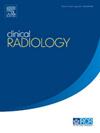Clinical outcomes of initially unablatable synchronous colorectal liver metastasis after conversion chemotherapy followed by percutaneous microwave ablation
IF 2.1
3区 医学
Q2 RADIOLOGY, NUCLEAR MEDICINE & MEDICAL IMAGING
引用次数: 0
Abstract
AIM
To evaluate the clinical outcomes of patients with initially unablatable synchronous colorectal liver metastases (sCRLM) who underwent percutaneous microwave ablation (MWA) following conversion chemotherapy.
MATERIALS AND METHODS
Patients with initially unablatable sCRLM who underwent chemotherapy followed by MWA between 2013 and 2021 were enrolled. According to ablatability criteria (tumour number ≤5, tumour size ≤3 cm), patients meeting these criteria after chemotherapy received curative-intent MWA (c-MWA group), while those exceeding them received palliative-intent MWA (p-MWA group). Overall survival (OS), intrahepatic progression-free survival (ihPFS), complications, and local tumour progression (LTP) were analysed and compared to initially ablatable cases undergoing radical MWA (r-MWA group).
RESULTS
The ihPFS of the p-MWA group was significantly shorter than c-MWA group and r-MWA group (5.1 vs 15.0 and 24.8 months, P < 0.001). The OS did not significantly differ among the three groups (53.0, 66.3, and 78.5 months, P = 0.95). After demographics matching, the c-MWA and r-MWA groups demonstrated similar ihPFS (15.0 vs 18.9 months, P = 0.96) and OS (66.3 vs 64.7 months, P = 0.69), with no statistical difference in LTP per lesion (6.4% vs 7.6%, P = 0.587). The p-MWA group had the highest complication rate (48.5% vs 32.9% and 15.2%, P < 0.001) and LTP per-patient rate (44.8% vs 20.5% and 9.9%, respectively, P < 0.001) compared to c-MWA and r-MWA groups.
CONCLUSION
Initially unablatable patients who successfully converted to ablatable status and underwent c-MWA achieve comparable ihPFS and OS to initially ablatable cases, while those who remained unablatable and underwent p-MWA experience shorter ihPFS. However, conversion chemotherapy before MWA might increase the rates of LTP per patient and complications.
转化化疗合并经皮微波消融后原发性不可缓解的同步结肝转移的临床结果
目的:评价原发性不可缓解的同步结肝转移(sCRLM)患者在转化化疗后经皮微波消融(MWA)的临床疗效。材料和方法纳入了2013年至2021年期间接受化疗和MWA治疗的最初无法缓解的scrm患者。根据消融标准(肿瘤数≤5个,肿瘤大小≤3cm),化疗后满足消融标准的患者接受治疗意图MWA (c-MWA组),超过消融标准的患者接受缓解意图MWA (p-MWA组)。分析总生存期(OS)、肝内无进展生存期(ihPFS)、并发症和局部肿瘤进展(LTP),并与最初接受根治性MWA的消融病例(r-MWA组)进行比较。结果P - mwa组ihPFS明显短于c-MWA组和r-MWA组(5.1个月vs 15.0个月和24.8个月,P <;0.001)。三组间OS无显著差异(53.0、66.3和78.5个月,P = 0.95)。经过人口统计学匹配,c-MWA组和r-MWA组的ihPFS (15.0 vs 18.9个月,P = 0.96)和OS (66.3 vs 64.7个月,P = 0.69)相似,每个病灶的LTP无统计学差异(6.4% vs 7.6%, P = 0.587)。P - mwa组并发症发生率最高(48.5% vs 32.9%和15.2%);0.001)和每位患者LTP率(分别为44.8% vs 20.5%和9.9%),P <;0.001),与c-MWA和r-MWA组相比。结论:最初无法消融的患者成功转化为消融状态并接受c-MWA的ihPFS和OS与最初可消融的患者相当,而那些仍然无法消融并接受p-MWA的患者的ihPFS更短。然而,MWA前的转换化疗可能会增加每位患者LTP的发生率和并发症。
本文章由计算机程序翻译,如有差异,请以英文原文为准。
求助全文
约1分钟内获得全文
求助全文
来源期刊

Clinical radiology
医学-核医学
CiteScore
4.70
自引率
3.80%
发文量
528
审稿时长
76 days
期刊介绍:
Clinical Radiology is published by Elsevier on behalf of The Royal College of Radiologists. Clinical Radiology is an International Journal bringing you original research, editorials and review articles on all aspects of diagnostic imaging, including:
• Computed tomography
• Magnetic resonance imaging
• Ultrasonography
• Digital radiology
• Interventional radiology
• Radiography
• Nuclear medicine
Papers on radiological protection, quality assurance, audit in radiology and matters relating to radiological training and education are also included. In addition, each issue contains correspondence, book reviews and notices of forthcoming events.
 求助内容:
求助内容: 应助结果提醒方式:
应助结果提醒方式:


